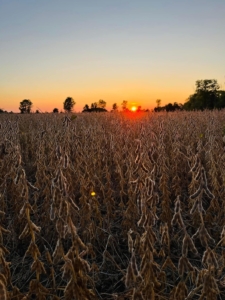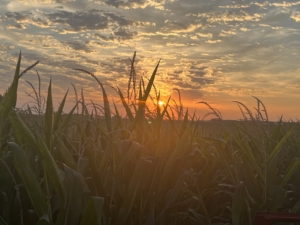AGRONOMIC UPDATE: September 18, 2024….Harvest is beginning….
Topics:
- GDU/Weather Update
- Corn – Soybean condition & Early Harvest trends…
TEMPERATURES & GDU ACCUMULATION:
As of September 18th, we have accumulated approximately the following for Growing Degree Units in 2024:
Planting Date GDD’s2024 Average GDD Departure from average
April 23 2641 2590 +51 (+3 days)
May 4 2558 2500 + 59 (+3.5 days)
May 14 2462 2410 +52 (+3 days)
Corn – Soybean Conditions…
- From the above numbers, we see that GDU accumulation has picked up over the last week or so as compared to the last update. We are at now reaching GDU numbers that get us close to black layer. The early maturity hybrids planted in April are at basically at black layer, which is matching the GDU numbers above. The fuller season hybrids planted in April are now 3/4 milk and should reach black layer next week. The mid-May planting dates are needing more time…still looking at needing till October 1 or so to reach close to black layer for full kernel depth and good test weights. Hybrids will adjust their maturity to later planting dates, meaning they often will mature using less GDU totals than rated. However, this can mean less kernel depth and test weights as compared to normal; especially in years like this one, where GDU accumulation has always been ‘behind’….any extra stress during a year like that, has the potential to compound the issue. Temperatures for September have been above normal. This has ‘pushed’ the crops along, but was much needed. Current long-term forecasts continue to predict normal to above-normal temps through October and dryer conditions….
- Corn staygreen heading into harvest will not be as good as last few years. 2024 has had too many stress events starting with planting conditions/heavy rainfall, periods of cool temps followed by heat, lack of rainfall during grain fill, to name a few. This has put more stress on the plant, reducing leaf area for photosynthesis, causing the plant to ‘work harder’ than normal to maintain yield.
- However, overall color has held up better than we anticipated, considering the heat/dry conditions of the past two weeks. Continue to monitor staygreen over next few weeks. Monitor those fields that lose color the quickest over next few weeks as they will be the first ones to go after for harvest. Due to the increased stress the crop experienced this year, we still expect stalk quality to be poor come mid-to-late October….
- See graphs below:
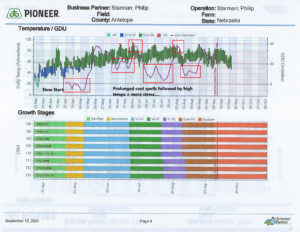
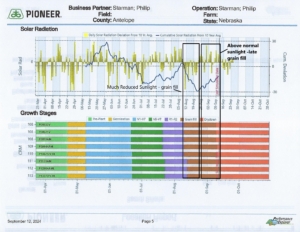
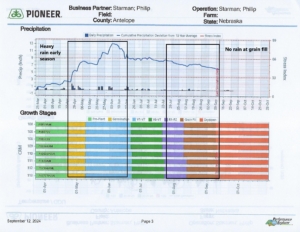
- Note in the first graph, the cold period during planting, and then the numerous prolonged cool spells followed by heat spells, that occurred throughout the summer. Our area experienced the 30th coldest July/August out of the past 132 years. Early cold/wet conditions slowed growth and impacted early root development, while the ‘ups-and-downs’ during the summer had the ‘plant engine’ running a little off.
- In the graph on sunlight, note the lack of sun during early grain fill, this can cause ear tip-back and puts stress on the plant by reducing energy production that is needed during peak energy needs. Thankfully, this has been followed by above normal sunlight, helping us ‘finish’ the crop in better shape than anticipated.
- The last graph shows precipitation. Note the high rainfall in May and June and the steady decline during grain fill. Thank goodness we received the early rains considering how dry grain fill has been. NE Nebraska saw the 16th driest July-Sep for precipitation in the last 132 years. This added stress to the crop as well, and is the reason we have ‘turned’ earlier than anticipated as well, especially soybeans over the past month.
- All of the above has lead to an increase in Fusarium Crown Rot as we continue to see more ears begin to drop and an increase in ‘ghost plants’ as the weeks progress. Tar Spot has increased over last week as well, while southern rust is just a ‘slow burn’.
- There is some very good corn in area irrigated fields, as kernel depth and color looks good as we move into the later half of September. We still expect to see more variability in irrigated yields this year versus past few years from the growing season we had. One of the biggest yield-limiting factors this year will still come from the early/heavy rains we received and the washed out areas/rows and drowned out spots that are in most every field. Second potential on yield will be ‘can we get it our before it wants to fall apart?’ There will be more standability issues this year than we have seen over the past number of years.
- Very early dryland corn/soybean yields seem to be good, much better than anticipated considering the dry July/Aug/Sep we had.
- Grain moisture drydown is dependent upon temperature and ear husk structure. Starting to see husks begin to open in fields now. On average, it takes 15-20 GDU’s to lower grain moisture each point from 30% down to 25%, 20-25 GDU’s per point of moisture from 25% to 22% and 25-30 GDU’s per point from 22% to 20%. A high of 75 degrees and a low of 55 degrees equate to 15 GDU’s, which should roughly take a point of moisture out per day when grain moisture’s are 25%+. So temps in the mid-70’s for highs and mid-50’s for lows should take corn from 30% to 25% in a week’s time. Forecasted temperatures for this weekend and through next week, will limit grain drydown, as we will accumulate only 10-15 GDU’s/day with the temps forecasted.
- Silage yields have been trending normal overall…hearing a lot of upper-20’s to mid-30’sT/A for tonnage.
- Soybean harvest moisture: There is an average yield reduction of 7-8% when going from 13% moisture to 8% moisture soybeans. This means an average loss of 6 bushels/acre (using an 80 bu yield) just in moisture, along with potential reduction from header loss, etc. The below chart shows the average yield lost from lower harvest moisture and delayed harvest over five year on-farm study from Pioneer.
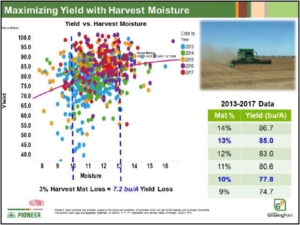
All for now. As harvest progresses, we will text out plot info and updates. Have a safe and successful harvest!!
Starman Seed & Supply, Inc.

